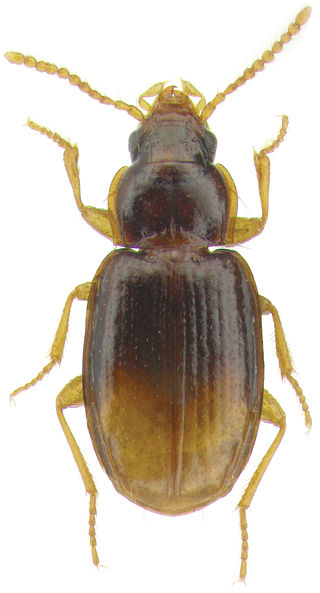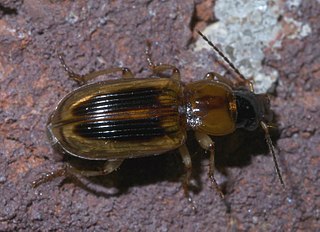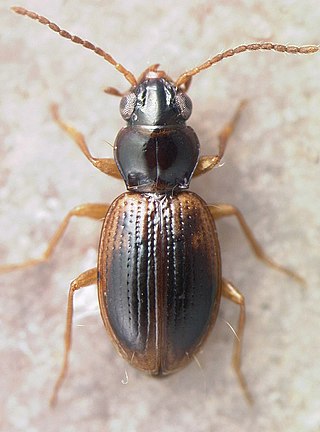
Mioptachys flavicauda is a ground beetle in the family Carabidae, in the suborder Adephaga . Mioptachys flavicauda is found in North America.

Anisodactylus opaculus is a ground beetle in the family Carabidae, in the suborder Adephaga . Anisodactylus opaculus is found in North America.
Discoderus parallelus is a ground beetle in the family Carabidae, in the suborder Adephaga . Discoderus parallelus is found in North America.

Stenolophus comma is a ground beetle in the genus Stenolophus, in the family Carabidae . Stenolophus comma is found in North America.
Scaphinotus imperfectus is a species of ground beetle in the family Carabidae, in the suborder Adephaga . It is found in North America.
Scaphinotus interruptus is a species of ground beetle in the family Carabidae, in the suborder Adephaga . It is found in North America.

Bembidion semicinctum is a species of ground beetle in the family Carabidae, in the suborder Adephaga. It was described by American entomologist Howard Notman in 1919.

Lebia ornata is a species of ground beetle in the genus Lebia, in the family Carabidae. It was described by American entomologist Thomas Say in 1823.
Bradycellus lineatus is a species of ground beetles in the family Carabidae. It is found in North America.
Scaphinotus andrewsii is one of 60 species of ground beetles in the family Carabidae. It is found in North America, living in moist areas and eat snails.
Acupalpus partiarius is a species of ground beetles in the family Carabidae. It is found in North America.
Bradycellus neglectus is a species of ground beetles in the family Carabidae. It is found in North America.
Morion aridus is a species of ground beetle in the family Carabidae. It is found in North America.

Selenophorus parumpunctatus is a species of ground beetle in the family Carabidae. It is found in the Caribbean and North America.
Agonum limbatum is a species of ground beetle in the family Carabidae. It is found in North America.
Amara pseudobrunnea is a species of seed-eating ground beetle in the family Carabidae. It is found in North America.

Pentagonicini is a tribe of ground beetles in the family Carabidae. There is at least one genus and about 10 described species in Pentagonicini.
Amara neoscotica is a species of seed-eating ground beetle in the family Carabidae. It is found in North America.
Platynus ovatulus is a species of ground beetle in the family Carabidae. It is found in North America.
Amara latior is a species of seed-eating ground beetle in the family Carabidae. It is found in North America.






